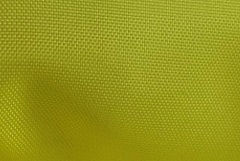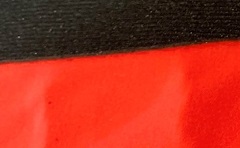| Polyester | |
 |
Polyester is a category of polymers that contain the ester functional group in their main chain. As a specific material, it most commonly refers to a type called polyethylene terephthalate (PET). Polyesters include naturally occurring chemicals, such as in the cutin of plant cuticles, as well as synthetics such as polybutyrate. Natural polyesters and a few synthetic ones are biodegradable, but most synthetic polyesters are not. The material is used extensively in clothing. Polyester fibers are sometimes spun together with natural fibers to produce a cloth with blended properties. Cotton-polyester blends can be strong, wrinkle- and tear-resistant, and reduce shrinking. Synthetic fibers using polyester have high water, wind and environmental resistance compared to plant-derived fibers. They are less fire-resistant and can melt when ignited. Polyester blends have been renamed so as to suggest their similarity or even superiority to natural fibers (for example, some varieties of China silk, which is an essentially deceptive term in the textiles industry for a synthetic fiber woven to resemble the sheen and durability of insect-derived silk, are 100% polyester or a polyester-rayon blend.) Liquid crystalline polyesters are among the first industrially used liquid crystal polymers. They are used for their mechanical properties and heat-resistance. These traits are also important in their application as an abradable seal in jet engines. Natural polyesters could have played a significant role in the origins of life. Long heterogeneous polyester chains and membraneless structures are known to easily form in a one-pot reaction without catalyst under simple prebiotic conditions. |
| Nylon | |
 |
Nylon is a generic designation for a family of synthetic polymers, based on aliphatic or semi-aromatic polyamides. Nylon is a thermoplastic silky material that can be melt-processed into fibers, films, or shapes. It is made of repeating units linked by amide links similar to the peptide bonds in proteins. Nylon polymers can be mixed with a wide variety of additives to achieve many different property variations. Nylon polymers have found significant commercial applications in fabric and fibers (apparel, flooring and rubber reinforcement), in shapes (molded parts for cars, electrical equipment, etc.), and in films (mostly for food packaging). Nylon was the first commercially successful synthetic thermoplastic polymer. DuPont began its research project in 1927. The first example of nylon (nylon 6,6) was produced using diamines on February 28, 1935, by Wallace Hume Carothers at DuPont's research facility at the DuPont Experimental Station. In response to Carothers' work, Paul Schlack at IG Farben developed nylon 6, a different molecule based on caprolactam, on January 29, 1938. Nylon was first used commercially in a nylon-bristled toothbrush in 1938, followed more famously in women's stockings or "nylons" which were shown at the 1939 New York World's Fair and first sold commercially in 1940. During World War II, almost all nylon production was diverted to the military for use in parachutes and parachute cord. Wartime uses of nylon and other plastics greatly increased the market for the new materials. |
| Recycled PET | |
 |
Recycled PET which is made from used drink PET bottles. Plastic bottles are made of PET, which can be melted and re-woven to be recycled into fabric, thus reducing waste in our environment. When plastic bottles are recycled they can be made into lots of things. |
| Spandex | |
 |
Spandex, Lycra or elastane is a synthetic fiber known for its exceptional elasticity. It is a polyether-polyurea copolymer that was invented in 1958 by chemist Joseph Shivers at DuPont's Benger Laboratory in Waynesboro, Virginia. The name "spandex" is an anagram of the word "expands".It is the preferred name in North America; in continental Europe it is referred to by variants of "elastane", i.e. élasthanne (France), Elastan (Germany, Sweden), elastano (Spain), elastam (Italy) and elastaan (Netherlands), and is known in the UK, Ireland, Portugal, Spain, Brazil, Argentina, Australia, New Zealand and Israel primarily as Lycra. Brand names for spandex include Lycra (made by Koch subsidiary Invista, previously part of DuPont), Elaspan (also Invista), Acepora (Taekwang), Creora (Hyosung), INVIYA (Indorama Corporation), ROICA and Dorlastan (Asahi Kasei), Linel (Fillattice),and ESPA (Toyobo). Dupont textiles scientist Joseph C. Shivers was determined to find a fiber to replace rubber in garments. He made a breakthrough in the early 1950s when he used an intermediate substance to modify Dacron polyester.This modification produced a stretchy fiber that could withstand high temperatures. After nearly a decade of research the fiber was perfected in 1959. Originally called Fiber K, DuPont chose the trade name Lycra to distinguish its brand of spandex fiber. |
| Composite material | |
 |
stockfitting two or more matirial with Foundry. |
